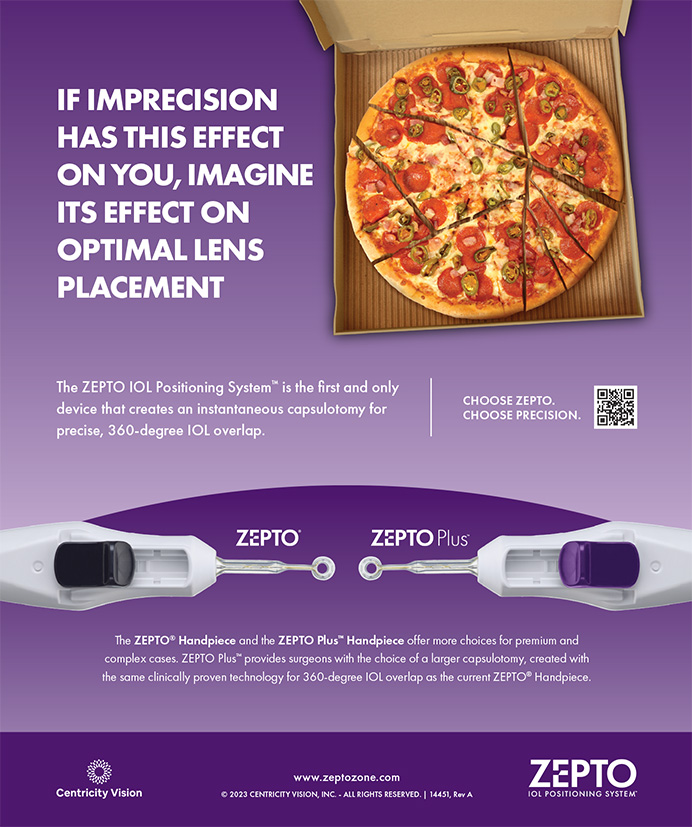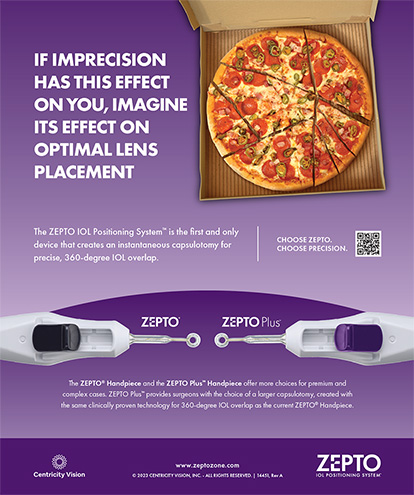We have performed refractive laser surgery with the 200-Hz Allegretto Wave laser (WaveLight, Inc., Sterling, VA) since January 2004 and currently have two of the first-generation lasers in our Houston and Austin, Texas, locations. In December 2006, we decided to purchase the recently approved Allegretto Wave Eye-Q laser (WaveLight, Inc.), which has a repetition rate that is twice the speed of the 200-Hz laser. After using both systems, we believe that the increased speed of the Eye-Q laser is an asset to the surgeon, because it shortens a long day of LASIK cases. The patients benefit from the reduced treatment time. According to our 1- and 3-month postoperative data, we achieved a 10 improvement in hitting our treatment target when using the 400-Hz compared to the 200-Hz system. When using the 400-Hz system, 20 more patients achieved a UCVA of 20/16 or better, and 35 more attained a UCVA of 20/20 or better at 1 month postoperatively. The 200-Hz system produces similar outcomes except at 3 months postoperatively. In addition, our practice benefits from the Eye-Q system because it minimizes enhancements, which translates into a financial advantage for the clinic.
SECOND-GENERATION LASER
In July 2006, the Eye-Q laser received FDA approval for standard myopic LASIK of up to -12.00 D with up to -6.00 D of astigmatism and for hyperopic treatments as great as 6.00 D with up to 5.00 D of astigmatism. In April 2007, the FDA granted the laser secondary approval for wavefront-guided and mixed-astigmatism treatments. Like the 200-Hz laser, the Eye-Q is a wavefront-optimized system that delivers specific ablation profiles based on each eye's unique corneal asphericity to preserve its natural shape. Maintaining the cornea's form improves visual outcomes, particularly in dim lighting conditions. With a 400-Hz repetition rate, the Eye-Q delivers 1.00 D of correction in only 2 seconds with in a 6.5-mm optical zone.
MAKING THE TRANSITION
While attending a company-sponsored User's Meeting in Vienna, Austria, last summer, we were intrigued when our international colleagues described achieving "tighter outcomes" with the Eye-Q laser. Because we were already satisfied with the results from the 200-Hz platform, we decided to purchase the new 400-Hz system when the need for a third laser at our practice became apparent.
Since we started using the new laser, we have minimized our learning curve. We do so by adopting the same nomogram that we were accustomed to using with the 200-Hz laser. Although we expected to make nominal refinements to the nomogram in the future, it has performed predictably for both laser platforms.
INITIAL IMPRESSIONS
In addition to the fact that our treatment times were cut in half, we noticed that the post-LASIK wow factor was more dramatic in patients treated with the faster platform. The reasons were that the shorter procedure reduced the dehydration of the stroma and flap and recovery time was also quicker. The predictability and safety data also seem to be incrementally better with the 400-Hz system, but further studies need to be conducted in order to confirm our impression.
Our most dramatic finding thus far relates to the improved comfort of the patient and physician with the 400-Hz laser. Because patients require less time for fixation during the treatment, they are noticeably less anxious and distracted, the movement of their eyes and heads is minimal, and the stability of the outcomes is enhanced. These differences are particularly noticeable with hyperopic patients, who typically require longer, more complex treatments.
SYSTEM'S ENHANCEMENTS
Functionally, the Eye-Q laser is based on the Allegretto Wave technology. It incorporates WaveLight's wavefront-optimized treatment profile. Several additional features include a brighter illumination system, a more precise eye tracker, and a cross-line projection that allows the surgeon to align the eye more precisely for treatment. In a future upgrade, we would like to see more flexibility with the slit lamp in terms of accommodating large patients.
PRACTICE-RELATED BENEFITS
We are confident that the Eye-Q laser has already paid for itself in the first 6 months we have owned it, because it can treat twice as many patients in the same amount of time as the 200-Hz laser. Patients' satisfaction has had a spiraling positive impact on the practice. They are treated quickly and achieve early gratification, often by 1 day postoperatively. The surgeons and staff appreciate that treatment days are noticeably shorter, and the technicians prefer the faster treatment and tracking times. Lastly, patients derive comfort from knowing that they are being treated with the latest technology available.
Mike Mann, MD, is Co-Medical Director at the Mann Eye Institute and Laser Center in Houston. He acknowledged no financial interest in the products or company mentioned herein. Dr. Man may be reached (713) 580-2500; mike.mann@manneye.com.
Paul Mann, MD, is Co-Medical Director at the Mann Eye Institute and Laser Center in Austin and Houston. He acknowledged no financial interest in the products or company mentioned herein. Dr. Man may be reached at (713) 580-2500; paul.mann@manneye.com.
Dana Ondrias, OD, is Executive Director at the Mann Eye Institute and Laser Center in Houston. She acknowledged no financial interest in the products or company mentioned herein. Dr. Ondrias may be reached at (713) 580-2500; dana.ondrias@manneye.com.


